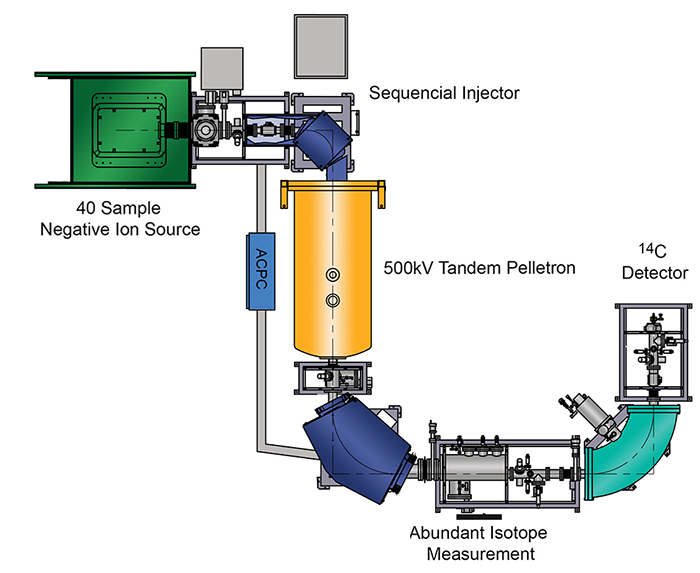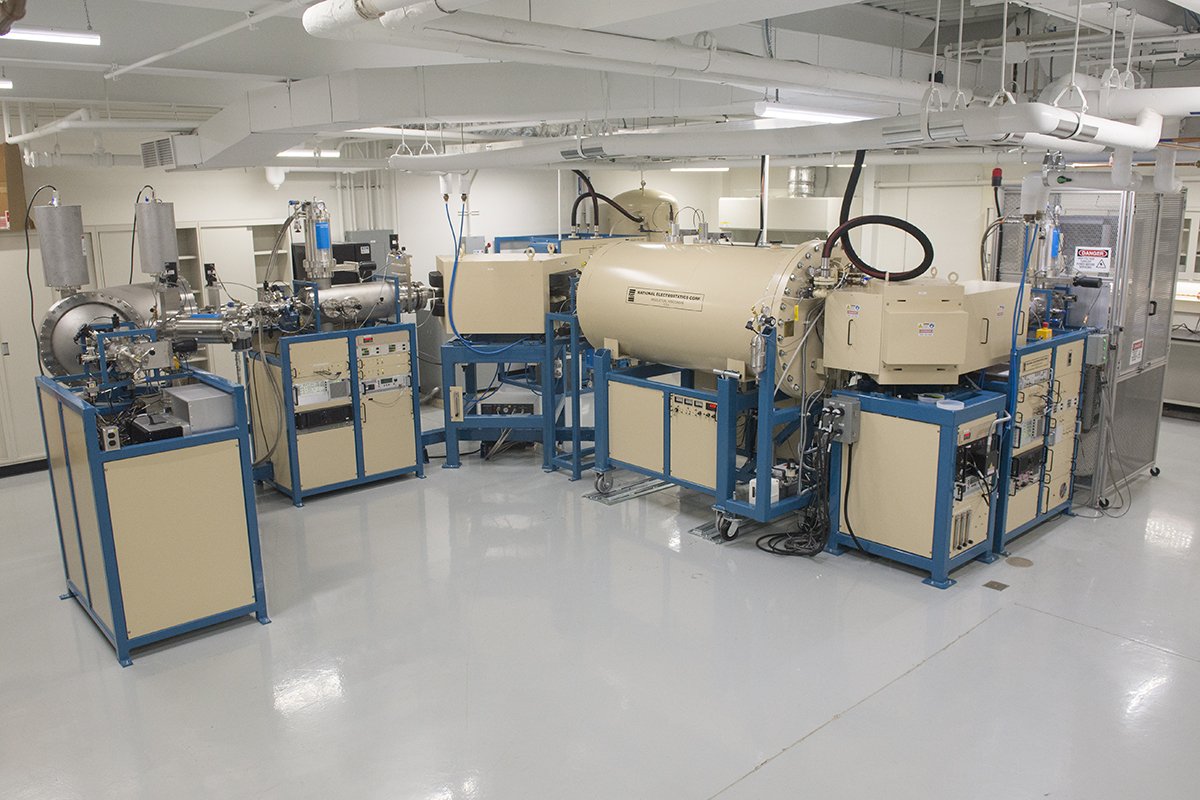How it works
An accelerator mass spectrometer measures the amounts of different isotopes within a sample. For carbon dating, the process starts in an ionizing chamber, where sample carbon atoms are given a negative charge and initially accelerated to an injection magnet where the particle beam is split by mass and sequentially injected into the accelerator.
Penn State's accelerator imparts almost 1 million electron volts to the ions and breaks apart interfering molecules. A larger analyzing magnet separates the sequential beam by bending the ions according to mass and directing them into two Faraday cups (for 12C and 13C mass) and a solid-state detector (for 14C mass radiocarbon). The ratio of 14C vs 12C in a sample and the known rate of 14C decay is used to estimate the age of the sample.

Equipment full name
National Electrostatics Corporation 500kV 1.5SDH-1 Compact Accelerator Mass Spectrometer (AMS)
Description

The Radiocarbon Laboratory is equipped with a National Electronics Corporation compact AMS with a 0.5MV accelerator (NEC 1.5SDH-1) installed in April 2016.
The AMS is optimized with a second einzel lens and solid ion source capable of routinely generating 12C- beam currents in the range of 120-150 µA on small (0.3-0.7 mg C) samples, roughly twice the current of similar low-energy AMS systems available to researchers. This allows for high-precision measurements of small individual samples and reduces the need for bulk or mixed materials to generate sufficient carbon for measurements. Thus, changes in 14C can be measured in incremental growth samples, such as:
- Tree rings
- Marine shell
- Speleothems
- Seeds
- Leaves
- Hair
- Other biologicals tissues
The primary modifications impacting analytical measurement error are the use of a spherical ionizer ion source operating at high cathode voltage (7V) to generate intense C- beams, plus injection beam line changes for better ion-optical matching to the accelerator. The injector modifications include a second einzel lens plus an increased ion source bias voltage running at 47.5 kV combined with a redesigned large-gap injector magnet (DF01319; Beverly et al. 2010). These alterations allow for analytical error in the 2-3‰ range for near modern samples under currents of up to 200 µA of 12C- and routinely generating 120-150µA of 12C- from ~0.7mg C samples. Radiocarbon ages are corrected for mass-dependent fractionation with δ13C values measured on the AMS and normalized to OXII standards (SRM-4990C). Sample sizes of 0.7mg C are routine, with somewhat lower precision on samples smaller than 0.3mg C. Any carbon-bearing material may be analyzed using the AMS.
Sample Sizes
AMS allows for high-precision 14C measurement on relatively small samples, with our optimal target being 0.7 mg of carbon. Lower precision 14C measurement is possible with smaller samples. The table below gives recommended size ranges for submitted materials. These guidelines are generally conservative because carbon content and state of preservation varies widely among organic and inorganic materials, among depositional context, and with age. That is, the values list below do not represent minimum samples. Please contact us if you have questions on specific material types.
|
Material |
Recommended amount |
|
wood (unburned) |
20-100 mg |
|
charcoal |
5-50 mg |
|
bulk sediment/peat |
10-100 g |
|
bone |
200-1000 mg |
|
bone collagen |
>5 mg |
|
hair/fibers |
10-100 mg |
|
carbonates |
25-50 mg |
|
calcined bone |
1-5 g |
